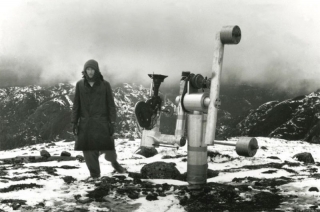Date: 19 September 2007 | Season: ZXZW 2007
LA RÉGION CENTRALE
ZXZW Festival at Tilburg FilmFoyer
Wednesday 19 September 2007, at 8pm
La Région Centrale is arguably the most spectacular experimental film made anywhere in the world, and for John W. Locke, writing in Artforum in 1973, it was “as fine and important a film as I have ever seen.” If ever the term “metaphor on vision” needed to be applied to a film it should be to this one. […] For this project he enlisted the help of Pierre Abaloos to design and build a machine which would allow the camera to move smoothly about a number of different axes at various speeds, while supported by a short column, where the lens of the camera could pass within inches of the ground and zoom into the infinity of the sky. Snow placed his device on a peak near Sept Îsles in Quebec’s région centrale and programmed it to provide a series of continuously changing views of the landscape. Initially, the camera pans through 360° passes which map out the terrain, and then it begins to provide progressively stranger views (on its side, upside down) through circular and back-and-forth motions. The weird soundtrack was constructed from the electronic sounds of the programmed controls which are sometimes in synch with the changing framing on screen and sometimes not. (Peter Rist)
Michael Snow, La Région Centrale, Canada, 1971, 180 minutes
PROGRAMME NOTES
LA RÉGION CENTRALE
ZXZW Festival at Tilburg FilmFoyer
Tuesday 19 September 2007, at 9pm
LA RÉGION CENTRALE
Michael Snow, Canada, 1971, 16mm, colour, sound, 180 minutes
La Région Centrale was made during five days of shooting on a deserted mountain top in Northern Quebec. During the shooting, the vertical and horizontal alignment as well as the tracking speed were all determined by the camera’s settings. Anchored to a tripod, the camera turned a complete 360 degrees, craned itself skyward, and circled in all directions. Because of the unconventional camera movement, the result was more than merely a film that documented the film location’s landscape. Surpassing that, this became a film expressing as its themes the cosmic relationships of space and time. Catalogued here were the raw images of a mountain existence, plunged (at that time) in its distance from civilization, embedded in cosmic cycles of light and darkness, warmth and cold. (Martina Sauerwald)
This new, three hour film by the Canadian Michael Snow is an extraordinary cinematic monument. No physical action, not even the presence of man, a fabulous game with nature and machine which puts into question our perceptions, our mental habits, and in many respects renders moribund existing cinema: the latest Fellini, Kubrick, Buñuel etc. For La Région Centrale, Snow had a special camera apparatus constructed by a technician in Montreal, an apparatus capable of moving in all directions: horizontally, vertically, laterally or in a spiral. The film is one continuous movement across space, intercutting occasionally the X serving as a point of reference and permitting one to take hold of stable reality. Snow has chosen to film a deserted region, without the least trace of human life, 100 miles to the north of Sept-Isles in the province of Quebec: a sort of plateau without trees, opening onto a vast circular prospect of the surrounding mountains. In the first frames, the camera disengages itself slowly from the ground in a circular movement. Progressively, the space fragments, vision inverts in every sense, light everywhere dissolves appearance. We become insensible accomplices to a sort of cosmic movement. A sound track, rigorously synchronized, composed from the original sound which programmed the camera, supplies a permanent counterpoint. Michael Snow pushes toward the absurd the essential nature of this ‘seventh’ art which is endlessly repeated as being above the visual. He catapults us into the heart of a world before speech, before arbitrarily composed meanings, even subject. He forces us to rethink not only cinema, but our universe. (Louis Marcorelles, Le Monde, 1972)
Back to top
